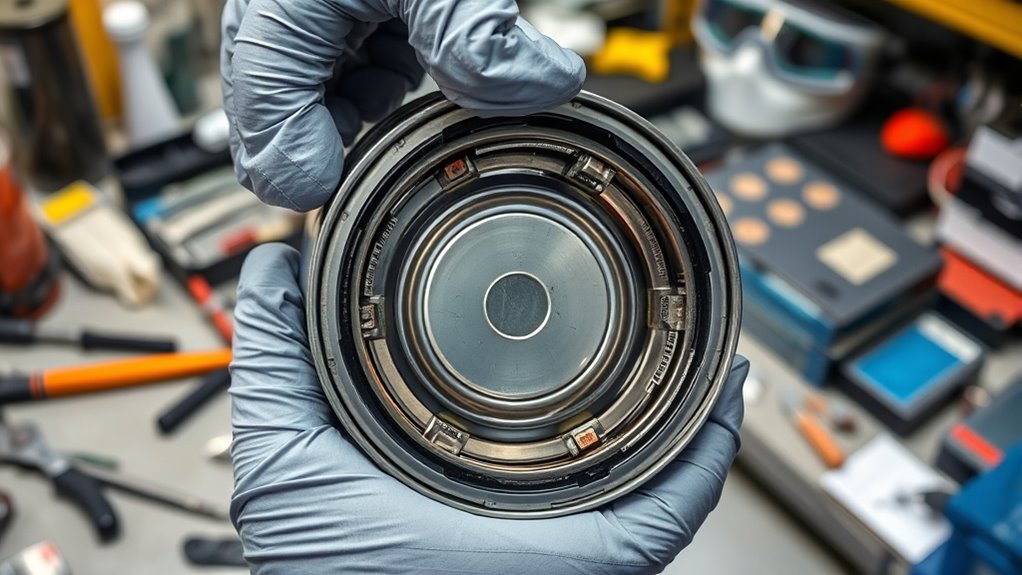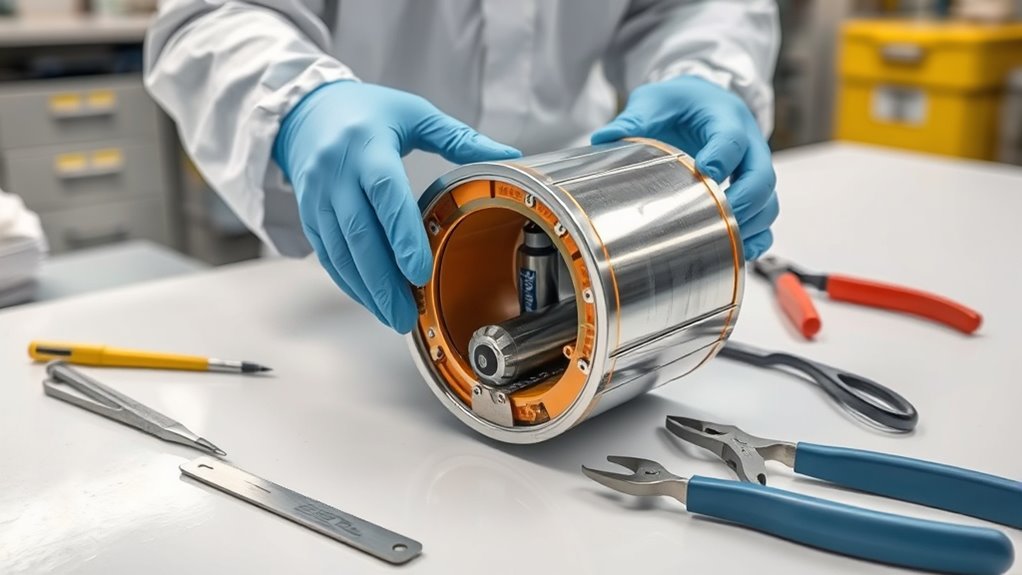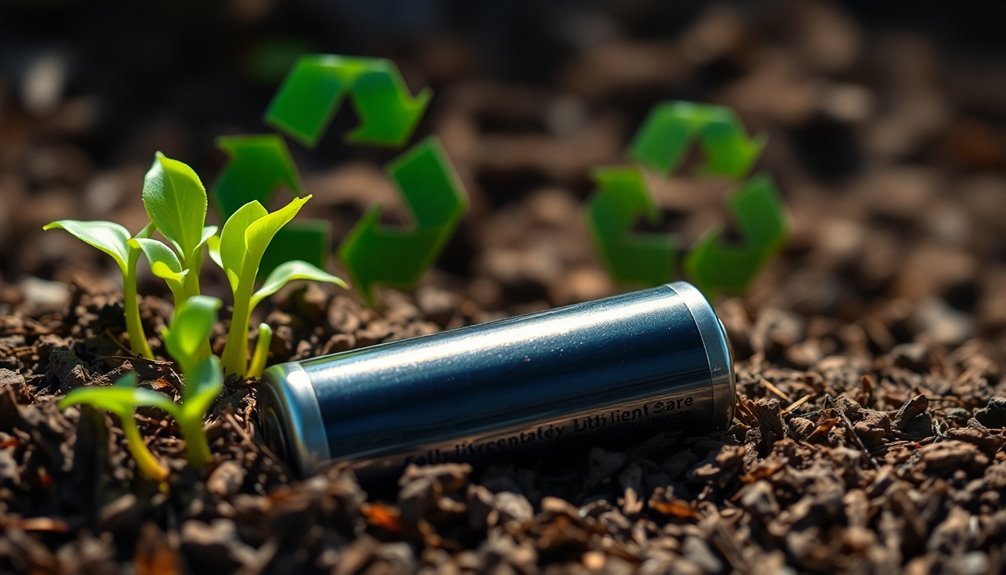To prepare batteries for reuse or recycling, you need to carefully disassemble them by safely removing external parts and internal components, using proper tools and protective gear. Focus on minimizing hazards like leaks or shorts, and then inspect and treat the parts—draining electrolytes and removing contaminants—based on battery type. Following strict safety guidelines and standards guarantees responsible handling and environmental protection. Keep going to discover key procedures and precautions that make the process safer and more effective.
Key Takeaways
- Carefully disassemble batteries by removing external casings, terminals, and covers using appropriate tools and PPE to prevent hazards.
- Segregate battery components (cells, electrolytes, circuit boards) by material type for safe handling and efficient recycling.
- Inspect, test, and neutralize residual electrolytes to ensure safety before reuse or recycling processes.
- Handle damaged or aging batteries with caution, following safety protocols to prevent chemical leaks or thermal runaway.
- Document disassembly and pre-treatment steps to ensure compliance with safety standards and environmental regulations.

Disassembly and pre-treatment of batteries are essential steps in ensuring safe and efficient recycling. When you begin this process, your primary focus should be on maintaining battery safety to prevent accidents or hazardous releases. Proper handling minimizes risks like fires, chemical leaks, or explosions, which can occur if batteries are not carefully disassembled. Adhering to strict recycling standards is critical here, as these guidelines help you manage dangerous materials responsibly and prevent environmental contamination. By following established protocols, you guarantee that the disassembly process is both safe for workers and compliant with regulations.
Prioritize safety and strict recycling standards to ensure responsible and secure battery disassembly and recycling.
During disassembly, you need to identify and carefully remove external casings, terminals, and protective covers. This step requires precision because damaged or improperly handled batteries can pose safety hazards. Using appropriate tools and personal protective equipment, such as gloves and eye protection, reduces the chance of accidental punctures or contact with harmful substances. Your goal is to access the internal components without causing any leaks or shorts. Once opened, you should segregate different battery parts—such as cells, electrolytes, and circuit boards—according to material type. Proper separation not only facilitates recycling but also minimizes the risks associated with handling hazardous materials.
Pre-treatment involves several preparatory steps that prepare the batteries for either reuse or recycling. For instance, if the batteries are to be reused, you must thoroughly inspect and test each component to guarantee it meets safety and performance standards. For batteries destined for recycling, pre-treatment often includes draining or neutralizing residual electrolytes, which can be corrosive or toxic. This step is essential to prevent chemical reactions during subsequent processing stages. You also need to remove any remaining contaminants, such as dirt or residual chemicals, to improve the efficiency of recycling operations and guarantee compliance with environmental safety standards. Additionally, understanding the types of batteries and their specific characteristics helps tailor the pre-treatment process effectively.
Safety remains at the forefront throughout pre-treatment. Handling batteries with care, especially those that are damaged or aging, helps prevent thermal runaway or chemical exposure. Proper documentation and adherence to safety protocols protect both you and the environment. Following recycling standards ensures that you dispose of or process batteries correctly, reducing hazardous waste and promoting sustainable practices. Whether you’re disassembling lithium-ion, nickel-metal hydride, or lead-acid batteries, applying these safety measures and standards guarantees that the entire process is responsible and effective. Ultimately, thorough disassembly and pre-treatment set the foundation for successful recycling or reuse, safeguarding health, property, and the planet.
Frequently Asked Questions
How Can Consumers Safely Disassemble Small Consumer Batteries at Home?
You shouldn’t try to disassemble small consumer batteries at home, as DIY safety risks are high. If you still choose to proceed, use the proper battery tools designed for safe handling, and wear protective gloves and goggles. Keep the workspace well-ventilated, avoid puncturing or damaging the battery, and disconnect power sources first. Remember, handling batteries improperly can lead to leaks, fires, or injuries.
What Are the Environmental Impacts of Improper Battery Pre-Treatment Methods?
Improper battery pre-treatment can cause toxic chemical leaks, harming the environment and posing health risks. When you skip proper procedures, these chemicals can seep into the soil, leading to contamination that affects plants, animals, and water sources. It’s essential to handle batteries correctly to prevent soil contamination and protect ecosystems. Always follow recommended disposal methods to minimize environmental damage and keep your community safe.
Are There Standard Safety Protocols for Large-Scale Battery Disassembly Facilities?
Yes, large-scale battery disassembly facilities follow strict safety protocols to ensure industrial safety and risk mitigation. You should implement thorough procedures, including proper personal protective equipment (PPE), hazard assessments, and safety training for all staff. Regular equipment inspections and emergency response plans are also essential. These protocols help prevent accidents, manage hazardous materials safely, and maintain a safe working environment during the disassembly process.
How Is Hazardous Waste Managed During Battery Pre-Treatment Processes?
You manage hazardous waste during battery pre-treatment with strict management practices, ensuring safety and environmental protection. Visualize secure containers, labeled clearly and sealed tightly, catching dangerous liquids and debris. You implement proper disposal protocols, often involving specialized treatment facilities that neutralize or safely store hazardous waste. By following these practices, you prevent contamination, protect workers, and comply with regulations, turning potential hazards into controlled, manageable waste streams.
What Innovations Are Emerging in Battery Disassembly Technology?
You see that emerging innovations in battery disassembly include automated disassembly systems and robotic sorting. These technologies streamline the process, increasing safety and efficiency by reducing human contact with hazardous materials. Automated disassembly handles complex tasks quickly, while robotic sorting accurately separates components for recycling or reuse. Together, these innovations help improve environmental sustainability and support the growing demand for efficient battery recycling solutions.
Conclusion
Think of battery disassembly and pre-treatment like tending a garden before planting. Just as you clear weeds and prepare the soil for new growth, carefully disassembling batteries and pre-treating their components set the stage for recycling or reuse. With each step you take, you’re nurturing a cycle that transforms waste into valuable resources, turning what once seemed discarded into the foundation for a more sustainable future. Your efforts help cultivate a cleaner, greener world.










